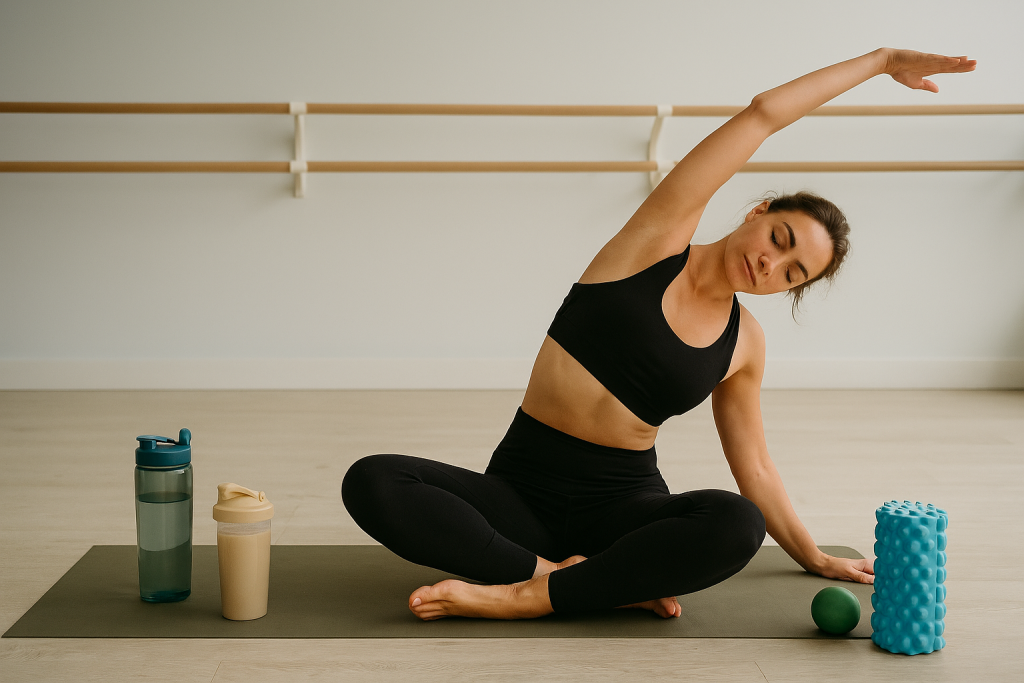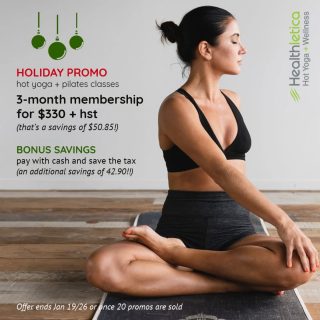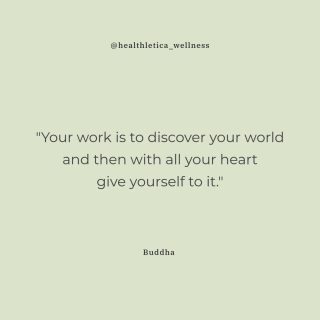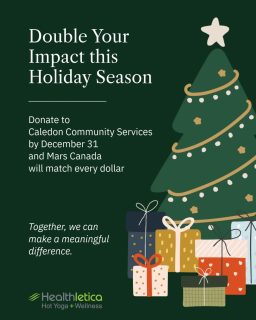Recovery is just as important as the workout itself. Whether you have just finished a sweaty hot yoga class, a challenging barre class, a mindful Pilates practice, or a strength training workout, how you recover can influence how quickly you bounce back, prevent injuries, and support long-term progress. Here are some essential recovery strategies to keep your body and mind in balance.
Stretching and Mobility Routines
Static stretching is best following a workout because your muscles are already warm, allowing you to safely hold stretches that improve flexibility, release tension, and promote recovery. It also helps to calm the nervous system and transition the body into a relaxed, post-exercise state. However, different workouts call for slightly different post-class stretches:
Hot Yoga: Choose gentle full body stretches such as supine spinal twist, child’s pose, and figure four stretch to restore calm and alignment.
Barre: Focus on stretches to improve muscle elasticity and reduce soreness. Prioritize the lower body, shoulders, and the obliques. Hip openers, side bends, pigeon pose, and hamstring stretches work well.
Pilates: Focus on key areas such as the core, shoulders, and hamstrings. Effective stretches include forward fold, butterfly stretch, and supine spinal twist.
Strength Training: Focus on emphasizing major muscle groups that were trained. For example, following upper body day, use cross-body shoulder stretch, overhead triceps stretch, and seated side stretch.
A simple rule: hold each stretch for at least 20-30 seconds, breathe deeply, and avoid pushing into pain to prevent injury.
Rest, Hydration, and Nutrition
Recovery is not only about what you do on the mat, but also about how you treat your body afterward.
Rest: Aim for quality sleep, reaching about 7-9 hours of sleep per night. It is also important to take active recovery days (such as gentle yoga or a light walk) instead of completing a hard workout daily.
Hydration: Replenishing fluids lost through sweat is crucial following exercise. Electrolyte-rich water or coconut water can help if you have completed an especially sweaty session.
Nutrition: Support muscle repair with lean protein (eggs, chicken breast, Greek yogurt), replenish glycogen with complex carbohydrates (whole grains, legumes, starchy vegetables), and reduce inflammation with antioxidant-rich foods (berries, leafy greens, nuts).
“Feeling sore after a workout isn’t always a bad thing—but if it’s happening frequently or lingering longer than expected, it could be a sign your body isn’t recovering optimally,” says Jennifer, exercise specialist and owner of Healthletica. “One of the first things I assess is protein intake. Many people aren’t consuming enough to repair and rebuild the muscle fibers that break down during exercise. Without adequate protein, you’ll not only feel sore more often—you’ll also struggle to make progress. I recommend aiming for at least 30 grams of protein three times a day, or about one gram per pound of ideal body weight. If you’re falling short, a high-quality protein powder can help bridge the gap. I’ve also found that supplements like l-glutamine and collagen may support recovery and reduce soreness, especially when combined with a well-rounded nutrition plan.”
Recovery Tools
Foam Rollers and Massage Balls: These help to reduce muscle pain and soreness, improve blood circulation, and aid in overall muscle recovery. Spend about 1-2 minutes on each muscle group.
Breathwork: Slow, mindful breathing (such as box breathing: inhale for 4, hold for 4, exhale for 4, hold for 4) activates the parasympathetic nervous system, reducing stress and aiding in recovery.
Contrast Showers: Following training, alternating between cold and hot water can help to promote recovery by reducing inflammation, increasing circulation, and reduced muscle soreness.
When to See a Physiotherapist
Some post-class soreness is normal, but there are times when professional help is needed:
- Persistent pain lasting longer than one week
- Sharp, localized pain during or after exercise
- Swelling, numbness, or limited mobility
- Recurrent injuries that interfere with your practice or exercise
Physiotherapists can assess movement patterns, identify muscle imbalances, and create tailored rehab plans to keep you moving safely. Click here to learn more about Healthletica’s physiotherapy program.
Recovery is not about being passive, it’s about actively supporting your body so it can adapt, grow stronger, and stay injury-free. By incorporating the right stretches, prioritizing hydration and nutrition, using recovery tools, and knowing when to seek professional help, you’ll get the most out of every workout class.
Article written by: Laura Cugliari, Kinesiology student at University of Guelph-Humber









